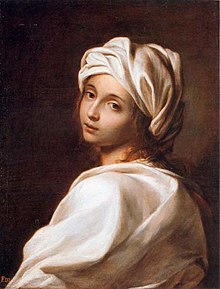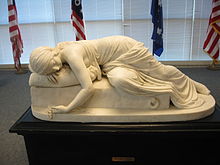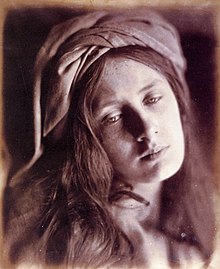
Beatrice Cenci (6 February 1577 – 11 September 1599) was an Italian noblewoman.
She is famous as the protagonist in events leading to a lurid murder trial in Rome that gave rise to an enduring legend about her.
Beatrice Cenci was the daughter of an aristocrat, Francesco Cenci, who, due to his violent temper and immoral behaviour, found himself in trouble with papal justice more than once.
The Cenci family lived in Rome at the Palazzo Cenci in the rione Regola, which was built over the ruins of a medieval fortified palace at the edge of Rome's Jewish ghetto.
The members of the extended Cenci family living together included Beatrice's elder brother, Giacomo, Francesco's second wife, Lucrezia Petroni, and Bernardo, Francesco's son from his second marriage.
A villa also was among the Cenci possessions, La Rocca of Petrella Salto, a small village near Rieti, northeast of Rome.
The Cenci family lived in Rome at the Palazzo Cenci in the rione Regola, which was built over the ruins of a medieval fortified palace at the edge of Rome's Jewish ghetto.
The members of the extended Cenci family living together included Beatrice's elder brother, Giacomo, Francesco's second wife, Lucrezia Petroni, and Bernardo, Francesco's son from his second marriage.
A villa also was among the Cenci possessions, La Rocca of Petrella Salto, a small village near Rieti, northeast of Rome.
According to historical details leading to the legend, il conte Francesco Cenci abused his first wife Ersilia Santa Croce and his sons and raped Beatrice multiple times thus being guilty of incest.
Francesco Cenci was jailed for other crimes, but due to the leniency with which the nobles were treated, he was freed early.
Beatrice Cenci tried to inform the authorities about the frequent mistreatments, but nothing happened although everybody in Rome knew what kind of person her father was.
When he found out that his daughter had reported him, he sent Beatrice and Lucrezia away from Rome to live in the family's villa at La Petrella del Salto in the Abruzzi mountains.
Francesco Cenci was jailed for other crimes, but due to the leniency with which the nobles were treated, he was freed early.
Beatrice Cenci tried to inform the authorities about the frequent mistreatments, but nothing happened although everybody in Rome knew what kind of person her father was.
When he found out that his daughter had reported him, he sent Beatrice and Lucrezia away from Rome to live in the family's villa at La Petrella del Salto in the Abruzzi mountains.
The four Cencis decided they had no alternative but to try to get rid of Francesco Cenci, and together organised a plot.
In 1598, during one of Francesco's stays at the villa, two vassals (one of whom had become Beatrice Cenci's secret lover) helped them to drug him, but this failed to kill Francesco.
Following this Beatrice, her siblings, and their stepmother bludgeoned Francesco to death with a hammer and threw the body off a balcony to make it look like an accident.
No one believed the death to be accidental, however.
In 1598, during one of Francesco's stays at the villa, two vassals (one of whom had become Beatrice Cenci's secret lover) helped them to drug him, but this failed to kill Francesco.
Following this Beatrice, her siblings, and their stepmother bludgeoned Francesco to death with a hammer and threw the body off a balcony to make it look like an accident.
No one believed the death to be accidental, however.
Eventually Francesco Cenci's absence was noticed and the papal police tried to find out what happened.
Beatrice's lover was tortured and died without revealing the truth.
Meanwhile, a family friend who was aware of the murder ordered the killing of the second vassal to avoid any risk.
Nonetheless, the plot was discovered and the four members of the Cenci family were arrested, found guilty, and sentenced to death.
The common people of Rome, knowing the reasons for the murder, protested against the tribunal's decision, obtaining a short postponement of the execution.
Pope Clement VIII, fearing a spate of familial murders (the Countess of Santa Croce had recently been murdered by her son for financial gain), however, showed no mercy.
Beatrice's lover was tortured and died without revealing the truth.
Meanwhile, a family friend who was aware of the murder ordered the killing of the second vassal to avoid any risk.
Nonetheless, the plot was discovered and the four members of the Cenci family were arrested, found guilty, and sentenced to death.
The common people of Rome, knowing the reasons for the murder, protested against the tribunal's decision, obtaining a short postponement of the execution.
Pope Clement VIII, fearing a spate of familial murders (the Countess of Santa Croce had recently been murdered by her son for financial gain), however, showed no mercy.
On 11 September 1599, at dawn, the Cencis were taken to Sant'Angelo Bridge, where the scaffold was usually built.
In the cart to the scaffold, Giacomo Cenci was subjected to continual torture.
On reaching the scaffold his head was smashed with a mallet.
His corpse was then quartered.
The public spectacle continued with the executions, first Lucrezia and finally Beatrice.
Both took their turns on the block to be beheaded with a small axe.
Only the 12-year-old, Bernardo, was spared, yet he, too, was led to the scaffold and forced to witness the execution of his relatives before returning to prison and having his properties confiscated (to be given to the pope's own family).
It was decreed that Bernardo Cenci should then become a galley slave for the remainder of his life, however, he was released a year later.
Beatrice was buried in the church of San Pietro in Montorio.
In the cart to the scaffold, Giacomo Cenci was subjected to continual torture.
On reaching the scaffold his head was smashed with a mallet.
His corpse was then quartered.
The public spectacle continued with the executions, first Lucrezia and finally Beatrice.
Both took their turns on the block to be beheaded with a small axe.
Only the 12-year-old, Bernardo, was spared, yet he, too, was led to the scaffold and forced to witness the execution of his relatives before returning to prison and having his properties confiscated (to be given to the pope's own family).
It was decreed that Bernardo Cenci should then become a galley slave for the remainder of his life, however, he was released a year later.
Beatrice was buried in the church of San Pietro in Montorio.
Beatrice then became a symbol for the people of Rome of resistance against the arrogant aristocracy, and a legend arose.
It related that every year on the night before the anniversary of her death, she comes back to the bridge where she was executed, carrying her severed head.
It related that every year on the night before the anniversary of her death, she comes back to the bridge where she was executed, carrying her severed head.
Beatrice Cenci has been the subject of a number of literary and musical works:
Philip Massinger's play "The Unnatural Combat" (1619) contains specific echoes of the case and ante-dates the Romantic revival of Beatrice Cenci by 200 years.
Percy Bysshe Shelley's verse drama The Cenci: A Tragedy in Five Acts (composed at Rome and at Villa Valsovano near Livorno, May–5 August 1819, published spring 1820 by C. and J. Ollier, London, 1819)
Les Cenci, a short story by Stendhal (1837)
Béatrix Cenci, a verse drama (1839), by Polish poet, Juliusz Słowacki
Beatrice Cenci, a novel by Francesco Domenico Guerrazzi (1854) -- based for the libretto set to music by Giuseppe Rota in 1863, perhaps the first melodramma based on the story.
"Beatrice Cenci (In a City Shop-Window)", (1871) a poem by Sarah Piatt, American poet.
Béatrix Cenci, by Astolphe de Custine
Nemesis, tragedy by Alfred Nobel
Beatrice Cenci, a play by Alberto Moravia.
Beatriz Cenci, a verse drama by Gonçalves Dias
Beatrix Cenci, opera by Alberto Ginastera, to a libretto by Girri and Shand, based on the Shelley play and on Stendhal.
Beatrice Cenci, opera by Berthold Goldschmidt, based on the Shelley play
Les Cenci (1935), play by Antonin Artaud, adaptation of the Shelley play
The Cenci, essay by Alexandre Dumas in Volume 1 of Celebrated Crimes (1840)
Legende und Wahrheit der Beatrice Cenci (1926), short story by Stefan Zweig
The Cenci (1951–52), an opera by Havergal Brian (abridged from Shelley's play)
The Cenci Family (2004), a radio play by Lizzie Hopley directed by Lu Kemp
Beatrice Cenci (2006), musical drama by Alessandro Londei and Brunella Caronti
Béatrice Cenci : Telle une fleur coupée", a novel by Jean Rocchi, editeur Esmeralda (10 mai 2004)
"Finis the Cenci" (1954), a 17-line poem by F. R. Scott in Events and Signals; also in his Selected Poems (1966) and Collected Poems (1981)
A Tale for Midnight (1955), a novel by Frederic Prokosch
the Canadian opera Beatrice Chancy, written by George Elliott Clarke and James Rolfe (and inspired by the Shelley play), transplants the story to nineteenth-century Nova Scotia.
Statues, paintings, and photography also provide numerous portraits and homages to Beatice Cenci:
The Italian painter Caravaggio witnessed Beatrice's public execution and may have used it as inspiration for the decapitation scene in his painting Judith Beheading Holofernes.
A statue by American sculptor Harriet Goodhue Hosmer entitled Beatrice Cenci (1857) stands at the Mercantile Library at the University of Missouri-St. Louis in St. Louis, Missouri, in the United States.
The early photographer Julia Margaret Cameron posed her model, May Prinsep, as Beatrice in an 1866 albumen print portrait among a series she devoted to Beatrice Cenci.
The painting of Beatrice Cenci by Mannerist painter Guido Reni (1575–1642) and the legend surrounding Beatrice figure prominently in Nathaniel Hawthorne's The Marble Faun (1860).
The book's two principal female characters, Hilda and Miriam, debate the nature and extent of Beatrice's guilt.
Hilda believes Beatrice's act to be an "inexpiable crime" but Miriam believes it was "no sin at all, but the best possible virtue in the circumstances".
Hawthorne draws many similarities between Miriam and Beatrice, and the reader must decide whether Miriam is an avenger or a culprit.
The book's two principal female characters, Hilda and Miriam, debate the nature and extent of Beatrice's guilt.
Hilda believes Beatrice's act to be an "inexpiable crime" but Miriam believes it was "no sin at all, but the best possible virtue in the circumstances".
Hawthorne draws many similarities between Miriam and Beatrice, and the reader must decide whether Miriam is an avenger or a culprit.
The Reni painting and the story of Beatrice figure in the plot of Liza Marklund's novel Last Will (2006).
Films have been inspired by the life of Beatrice Cenci also:
In David Lynch's film Mulholland Dr. (2001), Reni's painting is shown hanging in the Hollywood apartment of Ruth Elms as a reference to Cenci.
The 1969 Italian film Beatrice Cenci, directed by Lucio Fulci, follows the historical events of her life very closely.
Fulci always said it was one of his favourite films, even though he later became known for excessively gory horror films. It was also distributed under the title The Conspiracy of Torture.
Fulci always said it was one of his favourite films, even though he later became known for excessively gory horror films. It was also distributed under the title The Conspiracy of Torture.
The character played by Mia Farrow in the film Secret Ceremony is named Cenci, in reference to the Beatrice legend.
See also
References
- Beatrice Cenci (in Italian) Francesco Domenico Guarazzi "Beatrice Cenci" at Project Gutenberg.
 Chisholm, Hugh, ed. (1911). "Cenci, Beatrice". Encyclopædia Britannica 5 (11th ed.). Cambridge University Press. pp. 660–661.
Chisholm, Hugh, ed. (1911). "Cenci, Beatrice". Encyclopædia Britannica 5 (11th ed.). Cambridge University Press. pp. 660–661.
- ^ Peter Robb, "M: The Caravaggio Enigma" (Duffy and Snellgrove, 1998), p.96
|







No comments:
Post a Comment